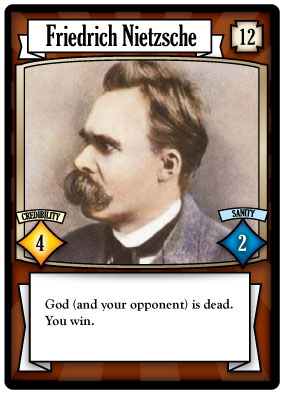My sister Melissa emailed me the other day to tell me that she and her colleagues in the Sociology department at the University of Notre Dame (she’s working on her Doctorate there) were looking at a stack of trading cards with pictures of famous thinkers on them. I guess one of them had bought them during their grad studies, and now the department was getting a good chuckle comparing the strengths and weaknesses of the various social theorists. Melissa mentioned it was too bad there was no set of rules to play with the cards as a game, “like have them have points or whatever so I could pit my Pierre Bourdieu against your Michele Foucault”.
This got me thinking. I scanned Wikipedia, and in about 15 minutes time, I produced this:
I posted it back to Melissa’s Facebook page with a couple of goofy one liners (“in the online version, the card text actually says ‘God is pwned’’, “once he evolves his PokéSkills, he can filter krill like a whale”), hoping that that would be enough to tip her off that this was not a real card from a real game. By all logic, I’d have guessed that she, knowing I am both a graphic designer with the capabilities of producing such an image as well as a gamer geek with a warped sense of humor, would immediately put greater odds on the possibility that I’d just made this on the spur of the moment for her amusement.
She didn’t. Her next post back to me was, “Where did you find this?”. In fairness, she did quickly realize that there was a good chance it was a fake, and then asked if I’d made it.
We then chatted about the possibility of a game that would use a card like this, and I suggested that what we were looking at was a game in which social theorists banded together to form a Barnum-style traveling circus where they competed to one-up each other through daring feats of physical (and metaphysical) and intestinal fortitude.
What I really find interesting in all of this though is the notion that if it looks like a game, there must be a game. Melissa knows enough of the non-standard board game world (by which I mean the games you won’t find in WalMart or Toys ‘R’ Us) that she doesn’t balk at the thought that someone, somewhere has made a game like this. I haven’t gone looking for it, but even I would guess that some twisted goof out there has devised a game that features these sorts of (occasionally questionable) geniuses of social theory as the primary characters. In this case, the suggestion of evidence of that game – my fake Nietzsche card – not only convinced someone, however briefly, that the game existed, it started a line of thinking that could ultimately bring that game into a real existence. So what about the gag gave it this much credibility?
Call me self-serving, but I believe it’s in the plausibility of the card’s visual design. The card bears a resemblance in its layout to other popular trading card games. It features a real illustration of the title character – borrowed from Wikipedia. it has three arbitrary number values on it’s face, arranged to appear to have some greater meaning in the context of a game. These alone suggest that it’s a game, but may not be enough to convince the audience that it’s a “real” game. I think that what puts this image over the threshold of plausibility is the subtler details of the card – the big-top radial burst in the background, the color toning, the drop shadows, gradients and lighting elements. As a designer, these visual elements are second-nature to me; in the right context, they’re what move a piece from rough concept to polished, finished work. Where I saw a few quick “tricks” to make the card look more aesthetically pleasing, even when it wasn’t necessary, my sister saw the fingerprints of an actual “studio-produced” game.
It may seem to be completely backwards; that a game should start with a concept and mechanics and gain aesthetics through it’s evolutionary development process. In this case, the theoretical game came from first an unlikely visual presentation that simply put strengths and weaknesses on pictures of people. This led to the question, “Why isn’t this a game?”, then to a joking mock-up of a piece of a game that never was. Ultimately, there’s now enough of a base to build the real thing from these ideas.
To a gamer, the more it looks like a game, the more likely it actually is a game — even when it’s not.

